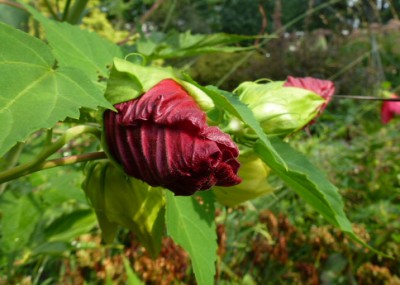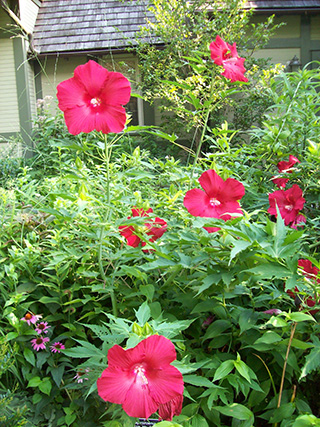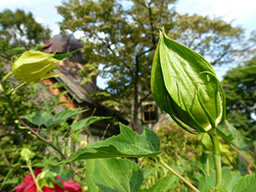Hibiscus
The Terry Shane Teaching Garden has many exciting moments throughout the growing season, but one of my personal favorites is when the hardy Hibiscus begins to flower. It brings a major accent to the garden outside of the Off Campus Study Office.
Hibiscus and other members of the family Malvaceae always have an added bonus with their specific and peculiar floral anatomy. All genera in this family exhibit some type of staminal fusion. The most common staminal fusion is know as “synfilamentous connation.” This is when the filaments (the thread-like structures on which the pollen bearing anthers of a flower are attached) are connate (fused as a part of natural growth), creating a tube through which the style and stigma protrude. This “petals-and-bottle-brush” effect can be seen on hollyhocks, rose-of-Sharon, or other mallows.
The genus Hibiscus allegedly borrows its name from the Greek word hibískos, a common name assigned by the Greek physician Dioscorides in his publication De Materia Medica as he described the marsh mallow Althaea officinalis.

The huge, 6 ” by 10″, lipstick-red flower of Hibiscus ‘Lord Baltimore’ is waiting to unfurl. photo credit: J. Bickel
For the month of September, the particular Hibiscus I wish to highlight is the cultivar Hibiscus ‘Lord Baltimore’. ‘Lord Baltimore’ has its beginnings, as the name suggests, in the eastern part of Maryland between Baltimore and Washington, D.C.
In the early 1950s, Robert Darby split his time working as a hardy Hibiscus breeder between Behnke nurseries in Beltsville, MD and the USDA. He began by mixing the halberd-leaf mallow Hibiscus laevis, the scarlet rose mallow Hibiscus coccineus, and the rose mallow Hibiscus moscheutos in an effort to create interesting cultivars for the gardening world.

Missouri Botanical Garden cites each Hibiscus ‘Lord Baltimore’ plant can produce up to 250 flowers per growing season. photo credit: J. Coceano
The very first cultivar he released and sold though Behnke nurseries was Hibiscus ‘Lord Baltimore’. This cultivar boasted huge, 6”-10” wide, waxy, lipstick-red flowers on 4’-8’ stems that brought an interesting, perennial, tropical-looking beauty to zones 4-5. A highly floriferous plant, each flower lasts about one day. Missouri Botanical Garden cites each plant can produce up to 250 flowers per growing season. Other hardy Hibiscus introductions from Robert Darby include H. ‘Lady Baltimore’, H. ‘Anne Arundel’, and H. ‘Turn of the Century’.
In the Terry Shane Teaching Garden, a small stand of these perennially and obediently mingle with Itea virginica ‘Henry’s Garnet’ and accent nicely with the reds of our hardy Begonia and the pinks of Lagerstroemia ‘Sioux’.







No Comments